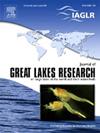休伦湖主流域金线鱼崩溃前后湖鳟的成鱼死亡率和年级强度
IF 2.4
3区 环境科学与生态学
Q3 ENVIRONMENTAL SCIENCES
引用次数: 0
摘要
无须鳕(Alosa pseudoharengus)的崩溃和野生湖鳟(Salvelinus namaycush)的全湖招募区分了休伦湖主流域湖鳟恢复的两个时间段。本文对湖鳟鱼成鱼死亡率和年级强度进行了比较,以探索湖鳟鱼丰度在金目鲷崩溃前迅速增加以及在金目鲷崩溃后维持湖鳟鱼状态的机制。种群指标是根据两个时间段的数据独立得出的,采用了最近描述的多年数据捕获曲线回归程序。2000 年之前的瞬时总死亡率远高于 2000 年之后的瞬时总死亡率。放养湖鳟的年级强度在很大程度上增加了 20 世纪 90 年代的年级强度。年级强度的增加和成鱼死亡率的降低,使 2000 年后初期的湖鳟数量达到最高。野生湖鳟最早出现在 20 世纪 90 年代的年级中,年级强度在 2000 年后,即 2003 年金目鲷崩溃之前真正开始上升,而在种群崩溃之前的 20 世纪 90 年代,金目鲷的生物量一直在持续下降。与野生湖鳟形成鲜明对比的是,放养湖鳟的年级强度在2000年后迅速下降。自 2000 年代后期以来,由于野生湖鳟和放养湖鳟都保持了较低的成鱼死亡率,它们的年级强度具有相似的动态变化,但放养湖鳟的变化似乎比野生湖鳟更大。本文章由计算机程序翻译,如有差异,请以英文原文为准。
Adult mortality and year-class strength of lake trout before and after alewife collapse in the main basin of Lake Huron
The collapse of alewives (Alosa pseudoharengus) and the lake-wide recruitment of wild lake trout (Salvelinus namaycush) distinguished two time-periods of lake trout rehabilitation in the main basin of Lake Huron. This paper compared lake trout adult mortality and year-class strength to explore the mechanisms for the rapid increase in lake trout abundance prior to the alewife collapse and the maintenance of lake trout status after the alewife collapse. The population metrics were derived independently from data for each of the two time-periods, using a recently described procedure of catch-curve regression with multiple years of data. Prior to 2000, the instantaneous total mortality rate was much higher than that for the post-2000 time-period. Year-class strength of stocked lake trout increased largely for those year-classes of the 1990s. The increases in year-class strength and decreases in adult mortality established the highest lake trout abundance at beginning of the post-2000 time-period. Wild lake trout first appeared with the year-classes of the 1990s, and the year-class strength really took off after 2000, prior to the 2003 collapse of alewives, while the alewife biomass was in steady decline during the 1990s before the population collapse. In contrast to wild lake trout, the year-class strength of stocked lake trout declined rapidly after 2000. Since the late 2000s, with the low adult mortality being maintained for both wild and stock lake trout, their year-class strength had similar dynamics although the variation for stocked lake trout appeared to be higher than that for wild lake trout.
求助全文
通过发布文献求助,成功后即可免费获取论文全文。
去求助
来源期刊

Journal of Great Lakes Research
生物-海洋与淡水生物学
CiteScore
5.10
自引率
13.60%
发文量
178
审稿时长
6 months
期刊介绍:
Published six times per year, the Journal of Great Lakes Research is multidisciplinary in its coverage, publishing manuscripts on a wide range of theoretical and applied topics in the natural science fields of biology, chemistry, physics, geology, as well as social sciences of the large lakes of the world and their watersheds. Large lakes generally are considered as those lakes which have a mean surface area of >500 km2 (see Herdendorf, C.E. 1982. Large lakes of the world. J. Great Lakes Res. 8:379-412, for examples), although smaller lakes may be considered, especially if they are very deep. We also welcome contributions on saline lakes and research on estuarine waters where the results have application to large lakes.
 求助内容:
求助内容: 应助结果提醒方式:
应助结果提醒方式:


